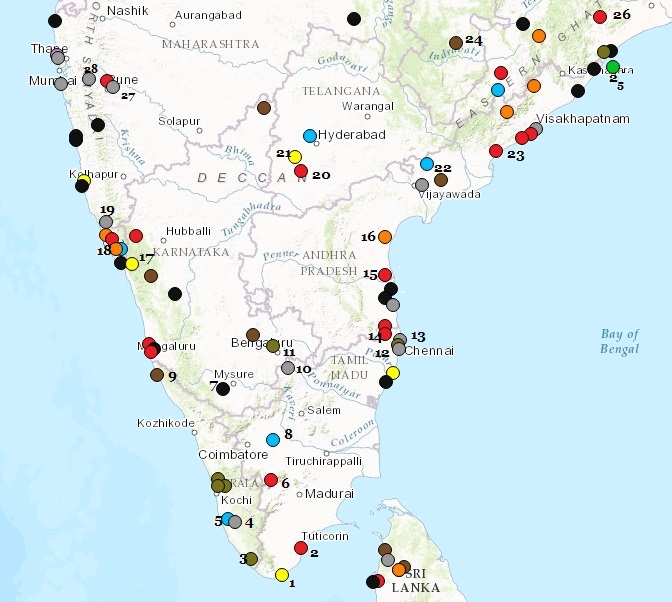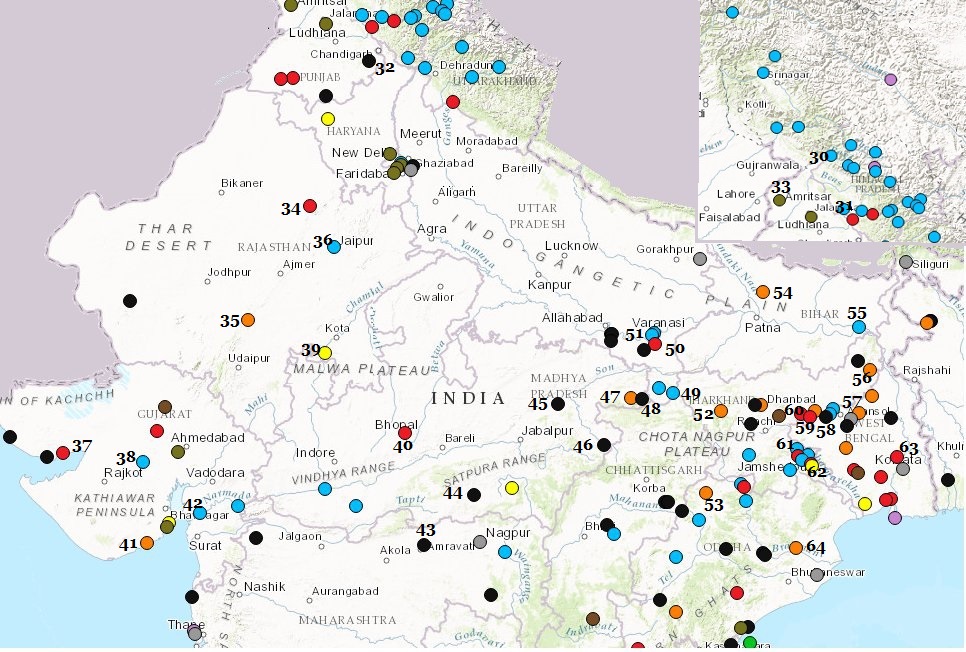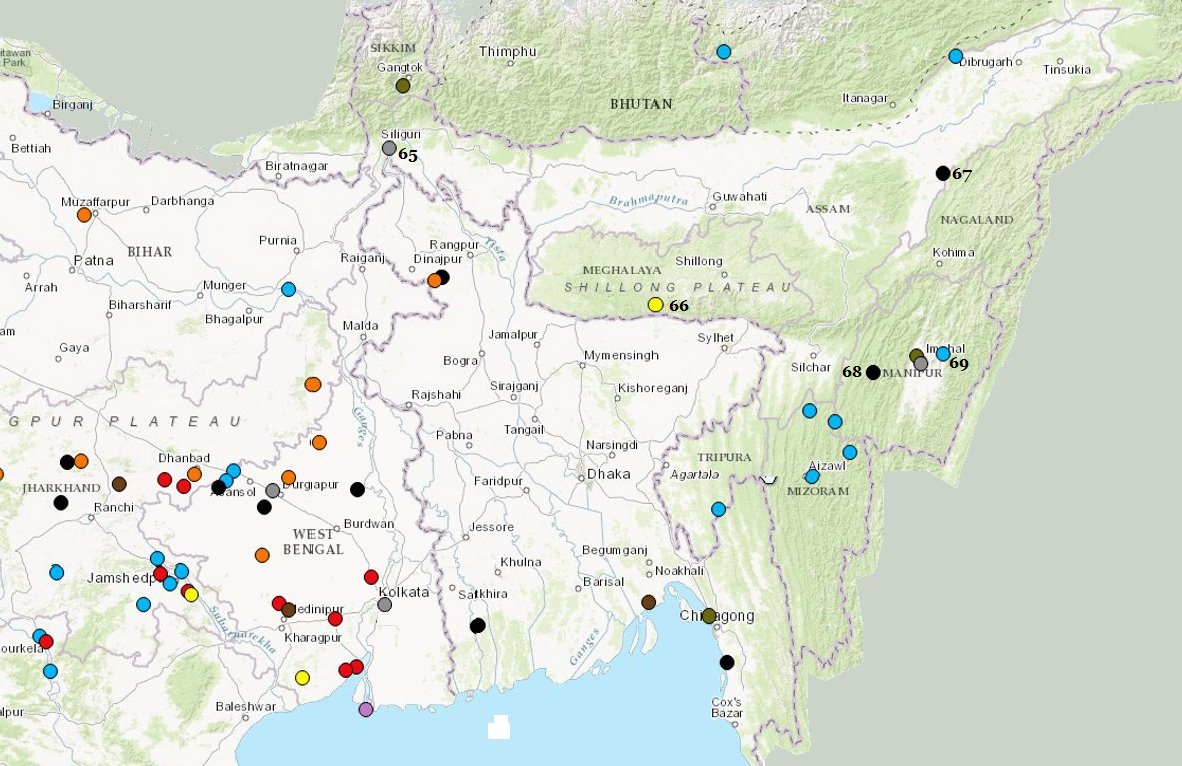BRICS FROM BELOW |
||
| HOME NEWS RESERCH SOLIDARITY MAPPING | ||
| PROTEST MAPPING | BRAZIL CHINA INDIA RUSSIA SOUTH AFRICA BRICS IN AFRICA | |
PROTEST MAPPING FOR INDIA
XXXXXXXXXXXXXXXXXXXXXXXXXXXXXXXXXXXXXXXXXXXXXXXXXXX
XXXXXXXXXXXXXXXXXXXXXXXXXXXXXXXXXXXXXXXXXXXXXXXXXXX
XXXXXXXXXXXXXXXXXXXXXXXXXXXXXXXXXXXXXXXXXXXXXXXXXXX
XXXXXXXXXXXXXXXXXXXXXXXXXXXXXXXXXXXXXXXXXXXXXXXXXXX
XXXXXXXXXXXXXXXXXXXXXXXXXXXXXXXXXXXXXXXXXXXXXXXXXXX
XXXXXXXXXXXXXXXXXXXXXXXXXXXXXXXXXXXXXXXXXXXXXXXXXXX
XXXXXXXXXXXXXXXXXXXXXXXXXXXXXXXXXXXXXXXXXXXXXXXXXXX
XXXXXXXXXXXXXXXXXXXXXXXXXXXXXXXXXXXXXXXXXXXXXXXXXXX
Back
|
|
FILTER BY Keyword |
||
| |
PROTESTS IN INDIAIndia has a high level of protests compatible to South Africa. Strikes are common, so are protests by communities over development (service delivery). Dalit’s and other marginal groups are prominent in these protests they also protest frequently over caste oppression which some argue is the main factor in the Naxalite insurgency, Protests over crime, student protests & protests by farmers over land expropriations for mining and other development projects also occur often.Its not just marginal groups such as the Dalits that protest but also middle class people such as lawyers and doctors. Protest tactics include Roko's (blockades) Marches, Hartal & Bandh (Local general strikes). Also Gherao (Occupation), fasts and suicides seem to be a particually Indian method of protest. While violence such as stone throwing and looting do occur it is less common than in SA during community protests. Communalist violence ie attacks on Moslems, Dalit’s don’t occur during protests. Protests over crime and injustices suffered by Dalits or by Caste Hindus are more likely to lead to be violent. http://ccs.ukzn.ac.za/files/BRICS%20Seminar-vol-3.pdf (Page 31) Bandhs called by polical parties or as result of disputes between states are frequent 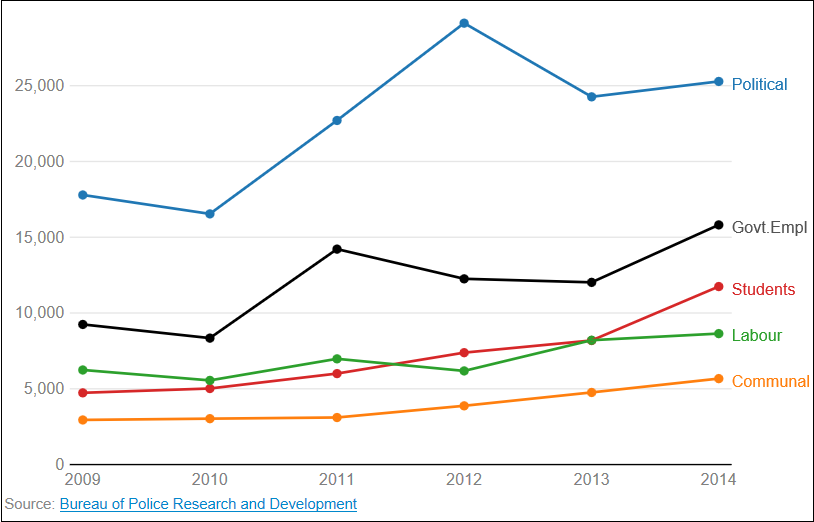
Protests 2009 -2014 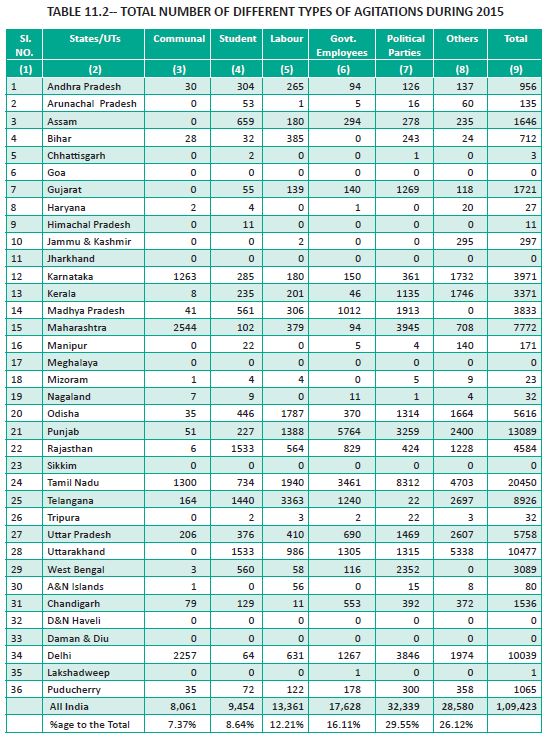 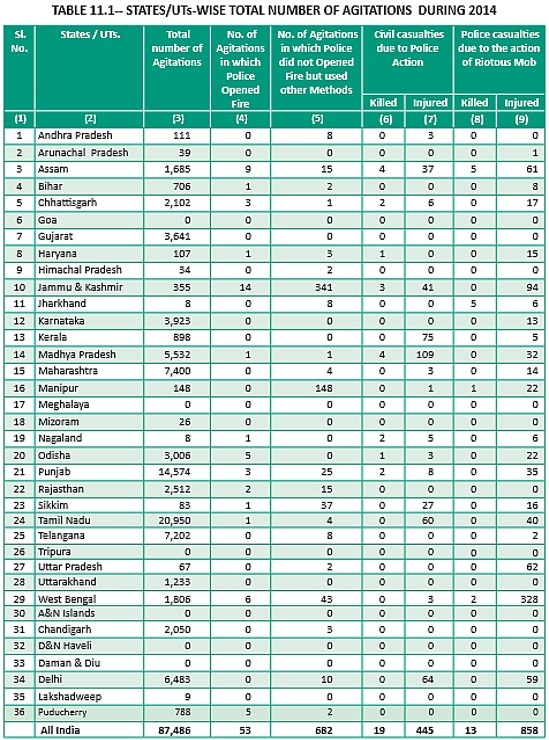 Source:Bureau of Police Research & Development 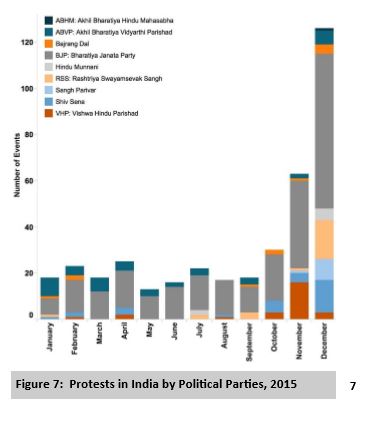 Protest by political parties 2016 Source:https://www.acleddata.com/wp-content/uploads/2016/09/ACLED_Asia_TrendReport_September2016.pdf INDIA PAKISTAN CONFLICT 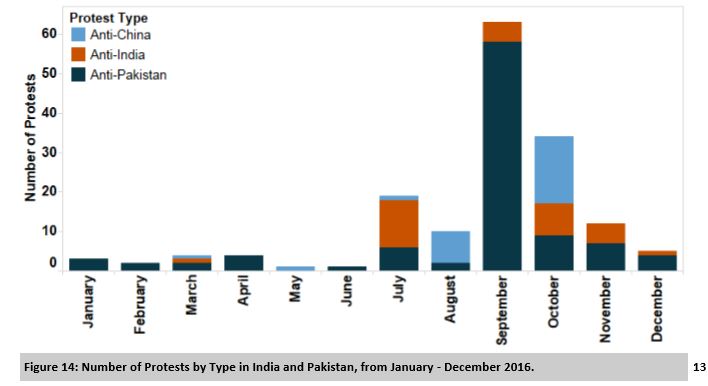 Source:https://www.acleddata.com/wp-content/uploads/2016/09/ACLED_Asia_TrendReport_September2016.pdf
Source:https://www.acleddata.com/wp-content/uploads/2016/09/ACLED_Asia_TrendReport_September2016.pdfSTRIKES AND OTHER PROTESTS BY WORKERS 180 million #WorkersStrikeBack in India 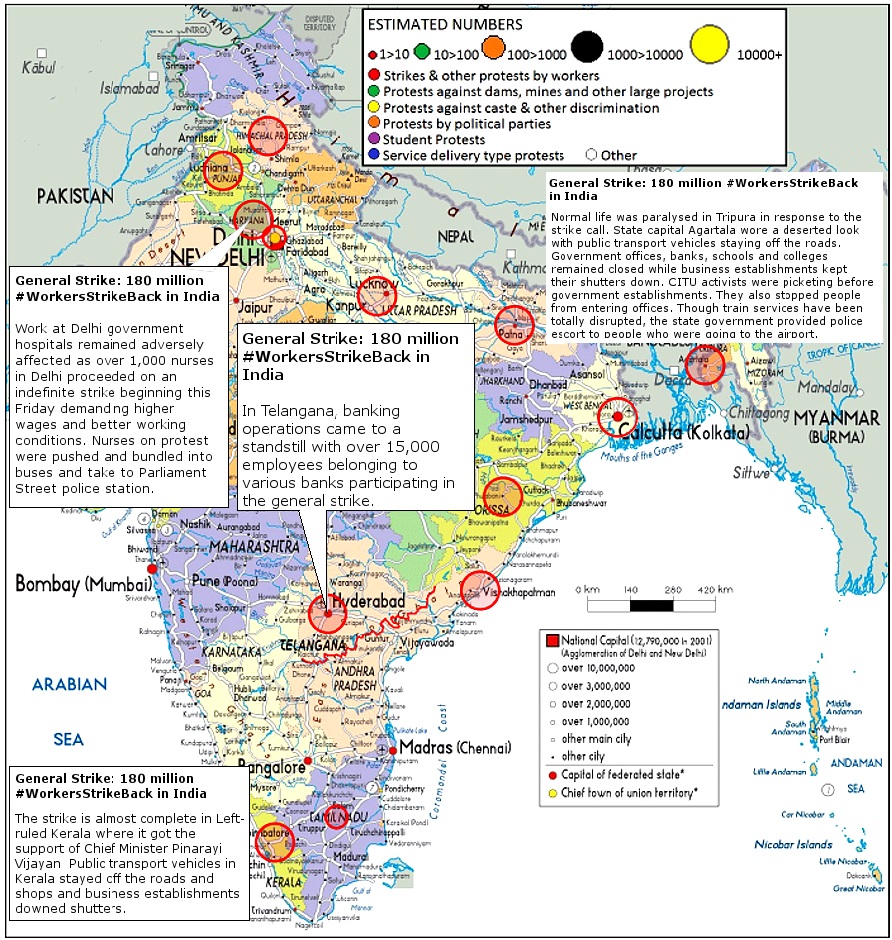 Major Singh 7 September 2016 On Friday the 2nd of September 2016 the biggest single strike action in world history took place in India. As many as between 150 and 180 million workers took part in the All India Strike around a 12 point charter of demands put forward by the Central Trade Unions. These included a raise to the minimum wage and pension for all workers, an end to privatization of state owned enterprises and contractorisation of the workforce, a halt to price hikes, the enforcement of labour rights and the scrapping of pro-employer labour law amendments. www.marxist.com/180-million-workersstrikeback-in-india.htm May Day 2016: Release the jailed 286 workers facing false charges CWI-INDIA 30 April 2016 Salute the Garment Women Workers of Bangalore:Fight for Rs. 100/-an hour Minimum Wage Yet again the trade unions of Bangalore city have missed a historic opportunity to have a united May Day programme, especially in the light of the recent heroic (or should we write HEROINIC) and successful sudden strike of Garment Workers, predominantly women, who emphatically defeated the evil capitalist designs of the Modi led Central Government which tried to steal the Provident Fund savings from the working class of this country. http://www.socialism.in/index.php/may-day-2016-release-the-jailed-286-workers-on-false-charges/ India:150 million workers strike Jagadish G Chandra, New Socialist Alternative (CWI-India) 7 September 2015 It is no exaggeration to say that the nation-wide strike on September 2nd was the biggest ever that India has seen since independence from direct colonial rule. Headlines in the western media declared: ‘World’s Biggest General Strike involves 150 million Workers!’ and the BBC, Al Jazeera and CNN carried exclusive reports on the strike. In India, the press and T V channels tried their level best to play down the impact and make it look inconsequential. But nothing had deterred the hitherto silent resolve of the workers to teach a lesson to the National Democratic Alliance government led by the right-wing communal BJP and the prime minister, Narendra Modi. In spite of great promises to ‘grow the economy’ beyond recognition, his government has, in the span of one year of its rule, further ruined the economic, political and social life of the working people of both urban and rural India. http://www.socialistworld.net/mob/doc/7324 India: 500,000 Coalminers strike against privatisation! Major Singh 3 February 2015 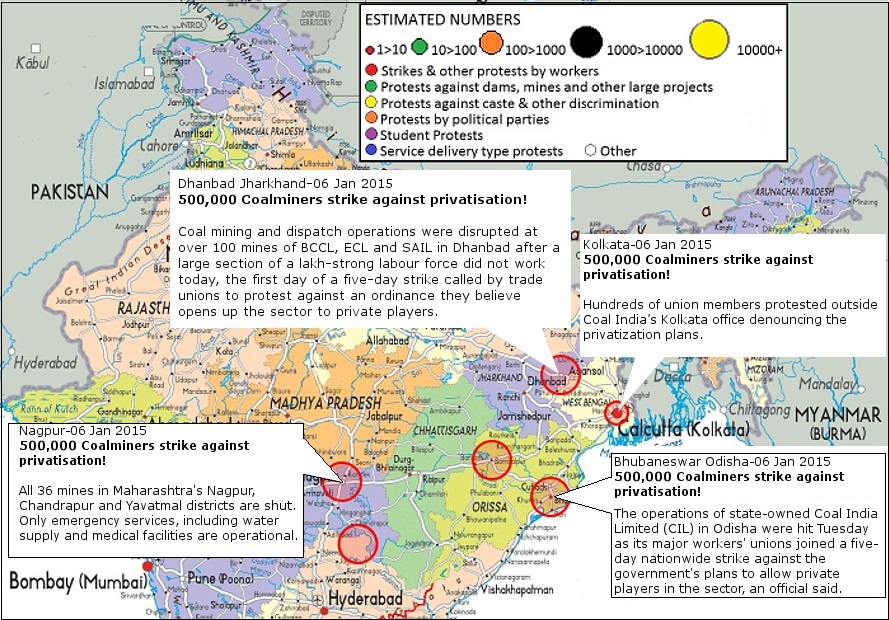 At the beginning of January 500,000 miners in the nationalised coal industry in India went on strike against governmental plans to privatise coal mining. This monumental show of strength in defiance of the Coal Ordnance law is indicative both of the tensions within Indian society and the pressure that is being brought to bear on the leadership of the working class to put up a fight. http://www.marxist.com/india-500000-coalminers-strike-against-privatisation.htm India: Alfa Laval Workers’ Strike New Socialist Alternative (CWI in India) reporters 19 January 2014 Workers from the Swedish company, Alfa Laval India Pvt Ltd. situated at Kasarwadi, Pune are on strike for the last three months (from September) with the main demand to make them permanently employed. Alfa Laval is involved in the production of heat exchangers. www.socialistworld.net/doc/6626 India: Over 100 million stop work Anand Kumar, New Socialist Alternative (CWI India), Bangalore 26 February 2013 The 48 hour general strike called by the Joint Committee of Trade Unions (JCTU), comprising of 11 Central Trade Unions, once again saw massive participation of the working class. On 20 and 21st February, over 100 million workers all over India participated to say ’No’ to neo-liberal reforms . Although the strike was declared a ’partial success’ by the mainstream (bosses’) media, the strike did see a major shutdown in many parts of India. The industry association, ASSOCHAM, estimated losses due to the strike at Rs. 26,000 crores ($ 4.77 billion). While this general strike comes after a gap of almost a year since the last one, last year also saw two major bandhs (shutdowns). These were called by the opposition parties – in May on the issue of the fuel price hike and in September against the ’big bang’ reforms such as Foreign Direct Investment by muiltinationals in retail. This strike is also the third time that all the Central Trade Unions have united on a common platform, including the INTUC organised by the governing Congress party, and the BMS, organised by the main right-wing opposition party, the BJP. The recent period has also witnessed massive protests by the youth and the urban salaried middle classes on the issue of the gang rape of a 23 year old student in Delhi - also a reflection of the growth of mass protest. http://www.socialistworld.net/mob/doc/6178 The other India rises in massive general strike Lal Khan 5 March 2012 After being coerced for decades in communal frenzy, sectarian violence, regional conflicts, caste prejudices, religious bigotry, nationalist chauvinism, regional antagonisms, democratic deception and cricket hysteria by the ruling classes and their harlot media, the Indian proletariat is awakening to the new epoch that is dawning across the planet. The 24-hour general strike that took place on 28th February is a turning point in the social and political evolution of present day India. http://www.marxist.com/other-india-rises-in-massive-general-strike.htm 2016 BANKNOTE DEMONETISATION On 8 November 2016, the Government of India announced the demonetisation of all ₹500 (US$7.40) and ₹1,000 (US$15) banknotes of the Mahatma Gandhi Series. The government claimed that the action would curtail the shadow economy and crack down on the use of illicit and counterfeit cash to fund illegal activity and terrorism. The sudden nature of the announcement—and the prolonged cash shortages in the weeks that followed—created significant disruption throughout the economy, threatening economic output. The move was heavily criticised as poorly planned and unfair, and was met with protests, litigation, and strikes. Anti demonetisation protests Nov-Dec 2016 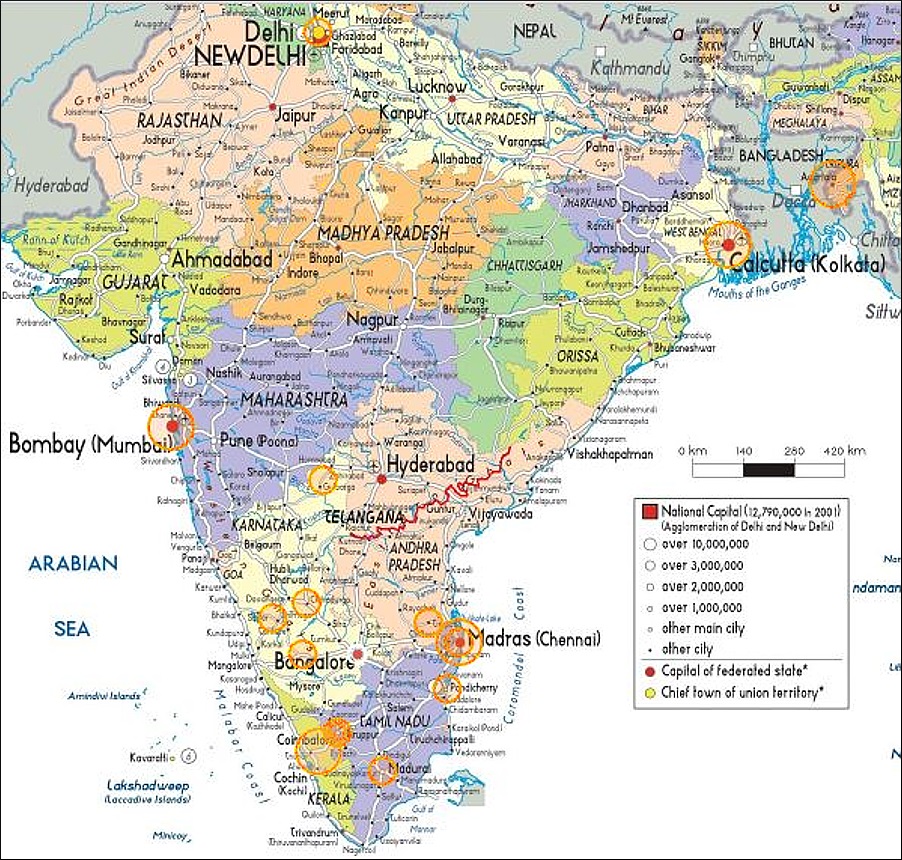 Opposition A Congress-led opposition which includes 13 political parties, opposed the current government on the demonetisation issue in the Winter Session of the Indian Parliament on 16 November 2016. The Chief Minister of West Bengal Mamata Banerjee also met the President Pranab Mukherjee to oppose the demonetisation. The debate on demonetisation is known to be initiated by Indian National Congress and Anand Sharma in the Rajya Sabha on 16 November 2016, while Banerjee is known to be the first to oppose the current government on the demonetisation. On 16 November 2016, Banerjee led a rainbow delegation comprising political parties of Trinamool Congress, Aam Aadmi Party, BJP ally Shiv Sena, Patidar Anamat Andolan Samiti (of Hardik Patel) and National Conference to Rashtrapati Bhawan to protest against the decision to withdraw the ₹500 and ₹1000 banknotes. A memorandum was submitted to the President of India Pranab Mukherjee demanding rollback of the decision. Outside the Parliament in a rally the same day, Saugata Roy, a member of parliament from the opposition Trinamool Congress Party, commented, "People are in utter distress, especially the informal sector is totally disrupted. Poor people, daily wage earners, they're all facing difficulty." In the demonetisation debate on the first day of the winter session of Parliament at the Rajya Sabha, Pramod Tiwari from the Indian National Congress compared Narendra Modi to Benito Mussolini, Adolf Hitler and Muammar Gaddafi. Prem Chand Gupta, a member of the Rashtriya Janata Dal, questioned a statement of Modi from the unscheduled TV broadcast on 8 November, "If it was planned 10 months ago, how did RBI Governor Urjit Patel sign on new note?". Praful Patel, a member of the Nationalist Congress Party, stated that "the government was not even prepared to recalibrate the ATMs while announcing the move. People's suffering are unimaginable. Nobody is questioning the government's intention, but you are unprepared to execute the move". Later, the former Chief Minister of Uttar Pradesh Mayawati Prabhu Das stated the situation to "a financial emergency", by saying "It looks as if Bharat has shut down." Also, Sitaram Yechury from Communist Party of India, questioned the government on the demonetisation move by stating "only 6% of black money in India is in cash to drive his point that demonetisation won't curb illicit wealth." On 17 November 2016, in a rally against demonetisation of ₹500 and ₹1000 notes, led by the Chief Minister of Delhi Arvind Kejriwal and his West Bengal counterpart Mamata Banerjee at Azadpur Mandi, the biggest vegetable and fruits wholesale hub in the national capital; Kejriwal demanded the withdrawal of demonetisation in 3 days. Banerjee also stated "I give the government 3 day ultimatum, fix things or withdraw the demonetisation scheme". In the demonetisation debate on the second and third day of the Winter Session of Parliament, on 17 and 18 November 2016, the opposition and the government clashed over the demonetisation issue, bringing the house to continuous halts. On 24 November 2016, in the demonetisation debate, the former prime minister of India Manmohan Singh said "this scheme will hurt small industries, the farming sector. The GDP can decline by about 3 per cent due to this move", while he also questioned "I would like to ask the Prime Minister examples of countries where people have deposited their money in the banks and not allowed to withdraw their own money." and later also said "It is no good that on each day banks bring out new notifications. It doesn't reflect properly on Prime Minister's Office, Finance Minister and the Reserve Bank of India. Cooperative banking system has been prevented from handling cash". Singh at last termed the demonetisation move as an "organised loot, legalised plunder of the common people". Strikes As the demonetisation was opposed in both houses of the parliament, it triggered organised nationwide strikes across India. Opposition parties like Indian National Congress, Bahujan Samaj Party, Trinamool Congress, DMK, JD(U), AIADMK, Nationalist Congress Party, Left, Rashtriya Janata Dal and the Samajwadi Party decided to observe ‘Akrosh Diwas’ as, a protest campaign day on November 28 and launch protests in front of banks, demanding that money be returned to people. In the state of Bihar, 15 trains were blocked and stranded, while the states of West Bengal, Maharashtra and Uttar Pradesh saw protest marches and rallies led by opposition parties. In the state of Kerala, shops and business establishments were shut, with school and colleges closed throughout the state, while movements of private vehicles were also disrupted in Northern Kerala. The Congress party has decided to launch a nationwide movement to expose the "biggest scam" of independent India, said spokesperson leader Randeep Surjewala on 31 December 2016. The first phase would take place from January 1–10, second phase from January 11–20 and third phase from January 20–30. https://en.wikipedia.org/wiki/2016_Indian_banknote_demonetisation#Radical_groups THE TELANGALA MOVEMENT The Telangana Movement refers to a people's movement for the creation of a new state, Telangana, from the existing state of Andhra Pradesh in India. The new state corresponds to the Telugu-speaking portions of the erstwhile princely state of Hyderabad. After several years of protest and agitation, the central government, under the United Progressive Alliance, decided to bifurcate the existing Andhra Pradesh state and on 7 February 2014, the Union Cabinet unilaterally cleared the bill for the creation of Telangana. Lasting for almost a decade, this has been one of the most longlasting movements in South India. On 18 February 2014, the Lok Sabha passed the bill with a voice vote. Subsequently, the bill was passed by Rajya Sabha 2 days later, on 20 February. As per the bill, Hyderabad will be the capital of Telangana, while the city would also remain the capital of residual state of Andhra Pradesh for no more than ten years. On 2 June 2014, Telangana was created. https://en.wikipedia.org/wiki/Telangana_movement THE 2011 ANTI-CORRUPTION MOVEMENT The Indian anti-corruption movement, commencing in 2011, was a series of demonstrations and protests across India intended to establish strong legislation and enforcement against perceived endemic political corruption. The movement was named among the "Top 10 News Stories of 2011" by Time magazine. The movement gained momentum from 5 April 2011, when anti-corruption activist Anna Hazare began a hunger strike at the Jantar Mantar in New Delhi. The chief legislative aim of the movement was to alleviate corruption in the Indian government through introduction of the Jan Lokpal Bill. Another aim, spearheaded by Ramdev, was the repatriation of black money from Swiss and other foreign banks. Grievances of mass protesters focussed on legal and political issues, including political corruption, kleptocracy, and other forms of corruption. The movement was primarily one of non-violent civil resistance, featuring demonstrations, marches, acts of civil disobedience, hunger strikes, marches and rallies, as well as the use of social media to organise, communicate, and raise awareness. The protests were nonpartisan and most protesters were hostile to attempts made by political parties to use them to strengthen their own political agendas. https://en.wikipedia.org/wiki/2011_Indian_anti-corruption_movement PATIDAR RESERVATION AGITATION Starting in July 2015, the people of India's Patidar community,[A] seeking Other Backward Class (OBC) status, held public demonstrations across the Indian state of Gujarat. The largest demonstration was held in Ahmedabad on 25 August and was attended by thousands. Later, there were incidents of violence and arson across the state, resulting in a curfew in several cities and towns. Properties and vehicles worth crores[B] of rupees were damaged and destroyed. The state returned to normalcy by 28 August. Despite talks with the government, the agitation began again in September, and again turned violent on 19 September. The government announced a scheme which offered scholarships and subsidies to general category students on 24 September 2015 and a 10% quota of spaces reserved for economically backward classes in April 2016. The 10% reservation was quashed by the Gujarat High Court in August 2016. https://en.wikipedia.org/wiki/Patidar_reservation_agitation MARATHA KRANTI MORCHA The Maratha community has been protesting and organizing silent rallies across the state with each district witnessing large number of people participating. It is silent protest against rape and murder in Kopardi (district Ahmednagar), victim was minor school girl. The protesters demand death punishment to rapist as early as possible. No leader! No slogans! and cleaning of whole City/town after march is very interesting and welcoming part of this movement. Million of peoples come together to protest but no harm to any public property or damage to any private property is notable thing in this March. The reservation demand is also a part of this protest. In Maharashtra Maratha community demands reservation in education and government services, most of farmers committed suicide belongs to Maratha caste, division of lands in small pieces makes critical condition. Infertility, drought hit continuously to Maratha. 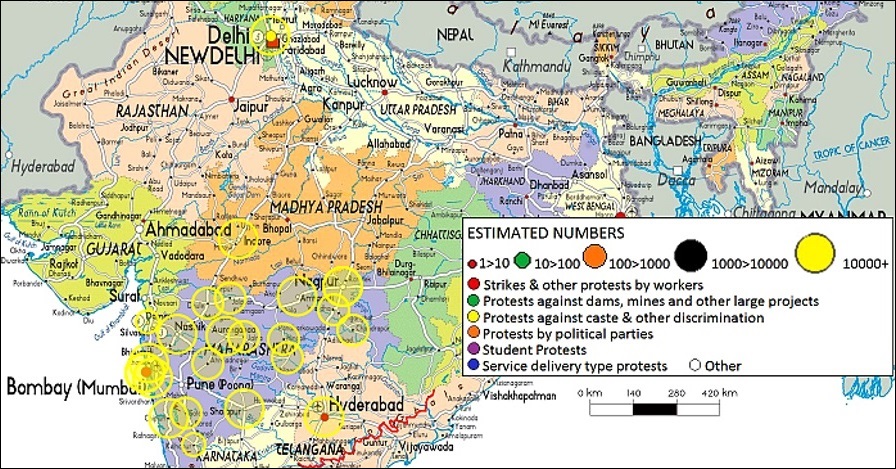
https://en.wikipedia.org/wiki/Maratha_Kranti_Morcha THE JAT RESERVATION AGITATION The Jat Reservation Agitation was a series of protests in February 2016 by Jat people of North India, especially those in the state of Haryana, which "paralysed the State for 10 days." The protesters sought inclusion of their caste in the Other Backward Class (OBC) category, which would make them eligible for affirmative action benefits. Besides Haryana, the protests also spread to the neighbouring states, such as Uttar Pradesh, Rajasthan, and also the National Capital Region. https://en.wikipedia.org/wiki/Jat_reservation_agitation#cite_note-DC_Sanjay_fire-26 2012 RAGE AGAINST RAPE Public protests took place in New Delhi on 21 December 2012 at India Gate and Raisina Hill, the latter being the location of both the Parliament of India and Rashtrapati Bhavan, the official residence of the President of India. Thousands of protesters clashed with police and battled Rapid Action Force units. Demonstrators were baton charged, shot with water cannon and tear gas shells, and arrested. Similar protests occurred throughout the country. More than 600 women belonging to various organisations demonstrated in Bangalore. Thousands of people silently marched in Kolkata. Protests occurred online as well on the social networking sites Facebook and WhatsApp, with users replacing their profile images with a black dot symbol. Tens of thousands signed an online petition protesting the incident. After Jyoti Singh's death on 29 December 2012, protests were staged all over India, including Kolkata, Chennai, Bengaluru, Hyderabad, Kochi, Thiruvananthapuram, Mumbai and Visakhapatnam. Many of the mourners carried candles and wore black dress; some pasted black cloth across their mouths. The following day a large number of people staged protests near Jantar Mantar, New Delhi. https://en.wikipedia.org/wiki/2012_Delhi_gang_rape http://www.socialistworld.net/mob/doc/6102 CAUVERY (KAVERI) RIVER WATER DISPUTE The sharing of waters of the [Cauvery river]has been the source of a serious conflict between the two states of [Tamil Nadu] and Karnataka. The genesis of this conflict rests in two agreements in 1892 and 1924 between the erstwhile Madras Presidency and Princely State of Mysore. The 802 kilometres (498 mi) Cauvery river has 44,000 km2 basin area in Tamil Nadu and 32,000 km2 basin area in Karnataka. The inflow from Karnataka is 425 TMC ft whereas that from Tamil Nadu is 252 TMCft https://en.wikipedia.org/wiki/Kaveri_River_water_dispute STUDENT PROTESTS 2014 Jadavpur University protests The Hok Kolorob Movement (Bengali: হোক কলরব আন্দোলন) or the 2014 Jadavpur University student protest, is an ongoing series of protests by the students of Jadavpur University in Kolkata, India that began on September 3, 2014. The term "Hok Kolorob" (literally, "let there be cacophony", Bengali: হোক কলরব) was originally the title of a song by Bangladeshi singer Arnob and began to be used as a hashtag on Facebook. On 16 September 2014, peaceful demonstrations by students took place in front of the administrative building of the University, demanding an investigation into the molestation of a female student in campus. Following several unsuccessful attempts at dialogue with the authorities, the students gheraoed some personnel of the University authority, including the Vice-Chancellor, Abhijit Chakrabarti. The Vice-Chancellor called the police. The subsequent police brutality unleashed upon the students in the early hours of September 17 triggered a wave of protests by students and teachers. Criticisms of the police brutality included that police used baton charge on a peaceful demonstration, that female students were manhandled and molested by male police officers, and that several men not in uniform attacked the students. The police maintain that there were plainclothesmen among their ranks while the students insist that these were Trinamool Congress (the ruling party of the state of West Bengal) cadres. The official position of the Calcutta Police is that "minimum lawful force" was applied to escort the Vice-Chancellor and other members of the committee out of the University. https://en.wikipedia.org/wiki/2014_Jadavpur_University_protests Witch hunt spree in Indian Universities CWI-INDIA 12 May 2016 While the mainstream corporate media has blackened out any serious coverage around the suspension and hounding of JNU students, the struggle of the students against the Modi government’s and its proxy, the university administration continues. Some of the JNU (Jawaharlal Nehru University) students have been on a hunger strike since April 27th, the day after the JNU administration issued out “punishments” to 17 students who were involved in the Febraury 9th event. While most students, including JNUSU president Kanhaiya Kumar, were awarded penalties and fines, Umar Khalid, Anirban Bhattacharya and Kashmiri student Mujeeb Gatoo have been suspended and banned from campus. In particular, Anirban has been rusticated for five years just as he nears the end of his PhD. http://www.socialism.in/index.php/witch-hunt-spree-in-indian-universities/ OTHER Stop the Kudan Nuclear Plant -Stop Police Terror CWI India 11 September 2012 The situation at Kudankulam has turned from worse to ugly. The state is determined to drown the three decade long peaceful protest in blood. Once the Chennai high court on 31st August, gave the green signal to fill the nuclear reactor with fuel, the valiant anti-nuclear fighters of Idinthakarai and surrounding villages decided to step up their struggle to a do or die battle. Tens of thousands of people from the 18 villages surrounding Koodankulam whose livelihood will be affected the most by the http://www.socialism.in/index.php/press-release-stop-kudankulam-nuclear-plant-stop-the-police-terror/ Anti- Posco Resistance Update CWI-INDIA 9 April 2012 The recent National Green Tribunal (NGT) judgment on the POSCO steel plant in Odisha asking the Environmental ministry to have a fresh re-look, while definitely a welcome relief to the people of Dhinkia and Gobindpur villages, is by no means a guarantee that POSCO is gone for good. If past experience is anything to go by, the government (both state and central) have bypassed all the so called democratic laws of the land in order to set up the steel plant. If it weren’t for the heroic 7-year long resistance put up by the people of these villages, the government and the company would long ago have destroyed this ecologically sensitive area and displaced its people. But despite the verdict, government it seems only wants to expedite the whole project. Both PM Manmohan Singh’s recent assurance to South Korea government and the new tripartite agreement that Biju Patnaik government is contemplating with POSCO, clearly reveals the mindset of the government that is hell bent on carrying the project forward. http://www.socialism.in/index.php/anti-posco-resistance-update/ |
 The EJ Atlas is a teaching, networking and advocacy resource. Strategists, activist organizers, scholars, and teachers will find many uses for the database, as well as citizens wanting to learn more about the often invisible conflicts taking place.
The construction of the Kudankulam nuclear plant in Tamil Nadu has been very contentious, particularly after the Fukushima disaster of 2011. Main protagonists have been the local fisherfolk. http://ejatlas.org/conflict/kudankulam-nuclear-power-plant-india 2 Sterlite copper smelter unit, India he ‘Anti-Sterlite People’s Committee’ has been protesting against the company Sterilite Industries (India) Limited since March 2013. The factory belongs to the company Vedanta Group. On 23rd March 2013, many people from neighbourhood areas fall sick following noxious gas leak (1). The gas caused mild suffocation, sore throat and eye irritation. Following the protest, Tamil Nadu Pollution Control Board issued a notice directing the Vedanta group company to close the plant. http://ejatlas.org/conflict/sterlite-copper-smelter-unit-india 3 Vilappilsala waste plant, Kerala, India Vilappilsala village located about 15 Kilometer away from Thiruvananthapuram, the state capital of Kerala. The village was selected for the dumping of urban waste generated from Thiruvananthapuram city. Left Democratic Front (LDF) government, in 2000 established this centralised waste processing plant for the capital city. Initially about 12-acre of government land was selected at Vilappilsala village for this purpose. The land was acquired by Kerala State government in 1995 for the city corporation’s use. The plant was planned by the city corporation and the initial plan to establish the plant was given to a private company. The plan was to install well equipped modern processing facilities to generate fertilizer from the biodegradable waste and leachate treatment. http://ejatlas.org/conflict/vilappilsala-waste-plant-vilappilsala-kerala-india 4 Aranmula greenfield Airport (AGA) project, India Aranmula is a village situated in the Pathanamthitta district of kerala. The village is known for its ancient Krishna temple and handicrafts and quite close to famous ‘Sabarimala Temple’. Government has recently announced for an airport, named Aranmula greenfield Airport (AGA). The project, costs about Rs 2,000 crore and will be built by Chennai-based KGS Aranmula international Airport Ltd. http://ejatlas.org/conflict/aranmula-greenfield-airport-aga-project-india 5 Coca Cola plant in Plachimada, Kerala, India Bottling plant shut down due to drought and pollution, after year-long people's protests and their wells being contaminated and dried up. What justice can be paid after such ecological disruption? http://ejatlas.org/conflict/coca-cola-kerala-india 6 Unilever refuses responsability for Kodaikanal mercury poisoning, India Unilever's thermometer plant in Kodaikanal exposed many workers to mercury poisoning, without giving them any protective equipment or information about the disastrous health effects of mercury. http://ejatlas.org/conflict/hindustan-unilever-thermometer-factory-kodaikanal-tamil-nadu-india 7 Chamalapura Thermal Power Plant, Karnataka, India Karnataka government has proposed a 1000 MW coal fired thermal power plant at Chamalapura, H.D.Kote taluk, Mysore district in early 2007. The project was proposed to built with a public-private partnership model. It was to be coordinated by the Power Company of Karnataka Ltd(PCKL), a Special Purpose Vehicle of the State Government. This region with its verdant agricultural lands is sandwiched between the Kabini and Cauvery rivers, and has a wide network of lakes. There are about 80 lakes (perennial and non perennial) lying within 8 km radius of Chamalapura. The proposed power plant is expected to result in land acquisition of 3000 acres (including 600 odd acres of forest lands) and displace at least 13,000 people, in Chamalapura & its neighboring villages. http://ejatlas.org/conflict/chamalapura-thermal-power-plant-karnataka-india 8 Noyyal River Basin, a pollution cocktail from textile industry, TN, India Garments industries polluting river basins. A study at University of Madras showed that more than half of the people interviewed reported health problems such as diarrhoea and cholera, while more than 75 per cent said they suffered skin diseases http://ejatlas.org/conflict/noyyal-river-basin-a-pollution-cocktail 9 Use of Endosulphan in Kasragod, Kerala, India Kasargod District is located in the southern part of India in Kerala State. This district is famous for its cashew plantation. Plantation Corporation of Kerala, a state government enterprise has cultivated cashew plant in the vast areas of this district. To protect this crop since the mid 1970s, the pesticide endosulfan has been widely used and aerially sprayed on cashew nut plantation covering several villages in the district http://ejatlas.org/conflict/use-of-endosulphan-in-kasragod-kerala-india 10 Special Economic Zone Hosur – GMR Krishnagiri Special Investment Region, TN, India Tamil Nadu State government through its executing agency Tamil Nadu Industrial Development Corporation (TIDCO) planned to establish a Special Economic Zone (SEZ) near Hosur, in Krishnagriri district of Tamil Nadu. TIDCO had obtained `in-principle' approval from the Ministry of Commerce and Industry, Government of India for establishing this SEZ. In 2006 the estimated cost of the proposed SEZ was about Rs. 512 crore. PricewaterHouseCoopers a global consultancy firm had conducted feasibility study of the SEZ in 2005. The district administration had also sent a proposal to the TN Government to get the administrative sanction for the project. Initially, the district administration had identified 1,053 hectares of land in the following villages; Bairamangalam, Kundumanapalli in Denkanikottai taluk and Achettipalli, Onnalvadi and Senamoa villages in Hosur taluk. http://ejatlas.org/conflict/gmr-krishnagiri-sez-limited-krishnagriri-hosur-tamil-nadu 11 Mavallipura Landfill Site at Bangalore, Karnataka, India avallipura village is located about 15 Kilometer away from Bangaluru (Bangalore). About 100 acres of land in and around the village are used for dumping Bangalore's municipal waste by the Bruhat Bengaluru Mahanagara Palike (BBMP– Greater Bangalore Municipal Corporation). In 2007, BBMP signed an agreement with M/s Ramky Environmental Engineers, a Hyderabad based company, to manage the waste collection and disposal. Since then, Ramky Environmental Engineers used to dump more waste than the landfill's capacity. In 2007, villagers alleged that the site is unregulated and did not adhere to the municipal Solid Waste Management Rules. According to them the company just collects and piles the untreated garbage at the site. As a result, the waste and its toxic chemicals are polluting nearby ponds lakes and even the ground water. The water hence polluted may even cause severe pollution to the Bangalore city’s water distribution system http://ejatlas.org/conflict/mavallipura-landfill-site-bangalore-karnataka-india 12 Chennai's seashore beautification and fisherfolk resistance, India Fisherfolk mobilize against gentrification of the beaches of Chennai. An expressway project was scrapped but private interests threaten people's livelihood. http://ejatlas.org/conflict/the-beautification-of-chennais-seashore-and-fisherfolk-resistance-india 13 Ennore coal power plant and Fisherfolk protest, north Chennai, India Ennore, North of Chennai, is a sacrifice zone with coal power plants, chemical industries, a port and a landfill. Fisherfolk protest against the pollution and encroachments affecting their livelihood. http://ejatlas.org/conflict/fishers-protest-destruction-of-mangroves-in-ennore-india 14 Thervoy SEZ, TN, India The Special Economic Zone (SEZ) is proposed on about 1,500 acres of 'meikkal poromboke' (wasteland) at Therovy Kandigai village in the Thiruvallur district of Tamil Nadu. However, the land is rich in herbs, fruits and wildlife and also serves as a catchment area in this village. http://ejatlas.org/conflict/thervoy-sez-tn-india 15 IFFCO Kisan SEZ in Nellore, AP, India Indian Farmers Fertilizer Cooperative Limited (IFFCO) had proposed to develop a Special Economic Zone (SEZ) in Nellore district of Andhra Pradesh, known as IFFCO Kisan SEZ (IKSEZ). The project is wholly owned by subsidiaries of IFFCO and mainly focused on Agro based products; it offers various customs duty, income tax and sales tax concessions provided by the Government of India to promote economic activity. It is inspired by the concept of "Integrated Agropark", defined as "systems innovation of metropolitan agro production, processing and logistics." http://ejatlas.org/conflict/iffco-kisan-sez-in-nellore-ap-india 16 Mining Project at Marlapadu village, India The Government of Andhra Pradesh reserved low grade Iron Ore deposit areas in Konijedu, Marlapadu villages in Prakasam District over an extent of 3,143 acres for exploitation in public sector. Local people, opposed to setting up of an iron ore extraction plant in the village, clashed with police in Dec 2011 (1). Villagers also boycotted public hearing on the proposed plant. http://ejatlas.org/conflict/mining-project-at-marlapadu-village-india 17 Kaiga Atomic Power Station, Karnataka, India The Kaiga Atomic Power Station is located in the Uttara Kannada district of Karnataka. The plant services India's southern grid and provides power to five states (Karnataka, Andhra Pradesh, Tamil Nadu, Kerala, and Pondicherry) In September 2011, Nuclear Power Corporation of India Limited (NPCIL) has announced the plant's expansion plan to add two more units (Unit 5 and Unit 6) to its existing four units. After the announcement local villagers were inspired by the protests against the Koodankulam nuclear plant in Tamil Nadu, the protestors claimed that the plant is threatening their lives as well as livelihood. http://ejatlas.org/conflict/kaiga-atomic-power-station-karnataka-india 18 Illegal mining and village protest in Caurem, Goa, India State violence in 2016 against tribal leaders in Caurem village in Goa who want to stop illegal iron ore mining and transport. http://ejatlas.org/conflict/caurem-illegal-mining-and-village-protest 19 Mopa International airport (North Goa), India State violence in 2016 against tribal leaders in Caurem village in Goa who want to stop illegal iron ore mining and transport. http://ejatlas.org/conflict/mopa-international-airport-north-goa-india 20 Polepally Special Economic Zone, Telangana, India Polepally SEZ is established by Andhra Pradesh Industrial Infrastructure Corporation (APIIC). It is one among many of the SEZ established by APIIC. It is situated at Polepally village, about 90 km from Hyderabad. Now it is in newly formed Telengana state. For the SEZ, land acquisition of about 1000 acre was notified in 2001. Original plans that year were to design as a “Green Industrial Park”. In 2005, the formulation "Special Economic Zone" was established and the land was allocated to many pharmaceutical firms engaged in the bulk manufacture of pharmaceutical products http://ejatlas.org/conflict/polepally-special-economic-zone-telangana-india 21 Nalgonda Uranium Mining, Andhra Pradesh, India Uranium Corporation of India Limited (UCIL) plans Uranium mining project in Lambapur and Peddagutta villages in P.A. Pally mandal of Nalgonda district in Andhra Pradesh. It is estimated that there are an estimated 11.02 million tonnes of uranium reserves spread over 1,326 acres, including a part of the Rajiv Gandhi Tiger reserve sanctuary. The announcement made by the government drew criticism from members of all the Opposition parties. This includes Telegu Dedham Party and the Left Parties. Opposing the proposed uranium mining, the members expressed the apprehension that radioactive material would contaminate Krishna river water and expose people in the surrounding areas as well as those living in Hyderabad to serious health hazards http://ejatlas.org/conflict/nalgonda-uranium-mining-andhra-pradesh-india 22 Polavaram Multipurpose Project, Andhra Pradesh, India The Polavaram multipurpose project has been under consideration since 1943. It was conceived as a storage scheme for the Godavari. The dam will come up at Polavaram, in between three districts of Andhra Pradesh, namely East Godavari, West Godavari and Khammam. In 1982, the Central Water Commission gave hydrological clearance to the project after the Godavari Water Disputes Tribunal recognized the need to go ahead with the project. In August 2005, the Andhra Pradesh High Court issued a stay order on all work related to the Polavaram project, on grounds that the government had not obtained the necessary clearances from the Ministry of Environment and Forests. The project was revived in October 2005, after the environment clearance was received. http://ejatlas.org/conflict/polavaram-multipurpose-project-andhra-pradesh-india 23 Kakinada Special Economic Zone, AP, India Government of Andhra Pradesh had taken initiative to promote about 115 Special Economic Zones (SEZs) in the state. Kakinada Special Economic Zone (KSEZ) is among one of these SEZs. It is located about 15 KM North of Kakinada deep water port in East Godavari District of Andhra Pradesh state. The proposed KSE will include industrial cluster of many industries and a deep-water port for importing and exporting petroleum, biotech, agricultural and other products http://ejatlas.org/conflict/kakinada-special-economic-zone-andhra-pradesh-india 24 Bastar conflict, Chhattisgarh, India From the mid-19th century onwards, the indigenous peoples of Bastar have lost their rights to the forests as a result of outside interference culminating in the Bastar Forestry Project which was jointly funded by the World Bank and the Indian Government in 1975. The objective was to develop and industrialise this “backward” region through 40000 ha of industrial plantation of the Caribbean pine (Pinus caribaea) for which the natural forests had to be cleared. For the indigenous peoples, the forest is an important source of income and sustenance. As they had no interest in cooperation or in job opportunities, local indigenous peoples resisted the commercial penetration into their environment. Their suspicion, resistance and hostility finally prompted the government – with the support of influential politicians – to terminate the pine plantation project. http://ejatlas.org/conflict/bastar-conflict-chhattisgarh-india 25 Shrimp farming at Chilika Lake, Odisha, India The conflict between the Chilika Lake indigenous dwellers and the local shrimp mafia continues for more than two decades with no hope in sight. http://ejatlas.org/conflict/fisherfolks-of-chilika-lake-odisha-india 26 Posco steel plant in Odisha, India A ten years struggle defending the land against a steel plant project by South Korean POSCO company pays off. On 8th April 2016 the company announced the scrap of the project for its long environmental litigation in the NGT and for the people's opposition http://ejatlas.org/conflict/posco-odisha-india 27 Videocon SEZ, Wagholi, MH, India Maharashtra government through its executing agency Maharashtra Industrial Development Corporation (MIDC) had proposed a Special Economic Zone (SEZ) at Wagholi, near Pune in Maharastra in 2007. This is one of many in the state; Maharashtra has in fact over 200 sanctioned SEZs of which nearly half would come up in the Konkan region and another 44 would be in the agro-rich Pune district. http://ejatlas.org/conflict/videocon-sez-wagholi-mh-india 28 Mahindra's SEZ at Karla, Maharashtra, India Mahindra Lifespace Developers Ltd proposed a Special Economic Zone (SEZ) at Karla village on the old Pune-Mumbai road in Pune District of Maharashtra. In 2006, the Mahindra group had received in-principle approval for setting up this SEZ. In 2006, the government had notified around 1,140 hectare of land for this project. The overall area of the proposed SEZ was to be spread over an area of 3,000 acres. Following the announcement, there was violent protests erupted at Karla by farmers as well as non farmer groups against the land acquisition process. Villagers' opposed the project because it will disconnect the road to the well-known temple of ‘Ekvira goddess’. The temple is located near the Buddhist era caves and of religious importance of the people inhabited in that area. Beside this, a number of villages were to be displaced. Many villagers did not want to shift their place of living under any circumstances. http://ejatlas.org/conflict/mahindras-sez-at-karla-maharashtra-india 29 Bauxite Mining in Paderu, Visakhapatnam, India AnRak Aluminium, a company of the government of Ras al-Khaimah of the United Arab Emirates and Penna Cement of AP has secured approval for both an aluminium complex and a bauxite mines in the Visakhapatnam district of Andhra Pradesh, but the final forest clearance for the mines is awaited. The AnRak project has replicated the Vedanta model of first building the refinery and then setting up the mine. The mine is to be operated by the state government to circumvent the ban on non-tribal landownership. http://ejatlas.org/conflict/bauxite-mining-in-paderu-visakhapatnam-india 30 Hul 1 and 2 small hydropower projects, HP, India Small but not so beautiful; stiff opposition to small hydelprojects in Western Himalayas bring plans to a halt. Are small size projects always less harmful than large ones? 31 Bhakra Nangal Project, India One of the earliest river valley development schemes undertaken by India after independence, it never met its original goals. After 50 years, affected villagers still waiting for reparations http://ejatlas.org/conflict/bhakra-nangal-project-india 32 Rajpura Thermal Power Project, Punjab, India Rajpura Thermal Power Project (Nalash) is a 1400 megawatt (2x700 MW) coal-fired power plant located at Nalas in Punjab. The first unit of the 700 MW super-critical (2x700 MW) Rajpura thermal power plant at Nalash village in Patiala district became operational in December 2013. The plant was inaugurated by Punjab Chief Minister Parkash Singh Badal. The next unit (700 MW) of the plant would come up by March 2014 http://ejatlas.org/conflict/rajpura-thermal-power-project-punjab-india 33 Bhagtanwala Solid Waste Management Plant in Amritsar, Punjab, India Municipal Corporation, of Amritsar had decided in December 2014 to start a modern Solid Waste Management Plant (SWMP) at the existing site of Bhagtanwala, Amritsar, Punjab. The proposed facility will be designed to cater the need of eight municipal bodies including Amritsar and seven others. The residents living in the nearby areas have strongly opposed the move. Even before the decision has been taken to modernize the facility, they staged a protest for the existing dump yard. It is observed that the dumping ground is the source of many diseases in the area. The residents afraid that if the proposed facility starts its operation, it will lead to health problems to about 50,000 people living in the locality. Also, according to the ‘Municipal Solid Waste Act’ a solid waste processing plant in a close vicinity of densely populated area is not permitted [1]. Beside this, the area is very close to a grain market and famous all over the country for wheat trading. Also, the famous Golden Temple is not very far from the site. The protestors said that the area is thickly populated and the municipality has informed the government and the high court by declaring Bhagtanwala as a village http://ejatlas.org/conflict/bhagtanwala-solid-waste-management-plant-amritsar-punjab 34 Nawalgarh Special Economic Zone, RJ, India Rajasthan State Industrial Development and Investment Corporation Ltd. (RIICO) planned to set up a Special Economic Zone in Nawalgarh District of Rajasthan. Accordingly, in 2007 the state government notified 5,769 hectares of land for three major cement producing companies for their plants and auxiliary mines. It granted over 4,600 ha to Ultratech Cement of Aditya Birla Group, 780 ha to Shree Cement of Rajasthan and 825 ha to India Cements of Chennai http://ejatlas.org/conflict/nawalgarh-special-economic-zone-rajasthan-india 35 Silicosis victims of stone quarries in Rajasthan, India Rajasthan is one of the rich mineral states of India. About sixty-four different kinds of metallic and non-metallic minerals, ores and deposits are available in the state. As a result various forms of mining activity are the second most employment generator in the state after agriculture. According to an estimate, over 3.1 million workers (most of them are tribal and dalits, economically and socially weaker section of the society) are engaged in the mining activity. Most of these workers work in sub-standard working condition without any standard wages, insurance and health facilities. So, unhealthy work conditions leads to occupational hazards and chronic diseases among the mining workers in the state http://ejatlas.org/conflict/silicosis-victims-of-stone-quarries-in-rajasthan-india 36 Coca Cola plant in Jaipur, India After depleting groundwater sources, Coca Cola leave Kaladera village with hundreds of affected families and farmers. The plant shuts down but what is the legacy for these people? http://ejatlas.org/conflict/coca-cola-jaipur-india 37 Bhadreshwar Thermal Power Plant, Gujarat, India OPG Power Gujarat Private Limited, a subsidiary of London-based firm, OPG Power Ventures PLC has received the in-principle approval to set up a sector-specific special economic zone (SEZ) for power at Bhadreshwar, Mundra, in Kutch district in Gujarat. The firm going set up a 300 megawatt (Mw) (two units of 150 Mw each), coal-based power plant in the SEZ. The company has acquired only part of the required land for the SEZ while it is in the process to acquire additional land. [1, 2] During the protest protesters were arrested following protests against OPGs proposed 300 MW power plant time to time. While in a public hearing for the Environment Impact Assessment (EIA) clearance of this proposed thermal power plant was organised in Bhadreshwar in May 2009 with strong protest from over 2,000 people from the affected population. Fishermen, salt-pan workers, pastoralists and farmers from the neighbouring villages participated in a rally prior to the hearing. Protesters submitted a memorandum enlisting their demands to the authority. http://ejatlas.org/conflict/bhadreshwar-thermal-power-plant-gujarat-india 38 Gujarat groundwater depletion, India Depletion of ground water leading to social conflicts and migration. Emphasis must be placed on collective action to reduce consumption and regulation of access. http://ejatlas.org/conflict/groundwater-depletion 39 Rajasthan Atomic Power Station (RAPS), India he Rawatbhata nuclear power station (RAPS) is built at Rawatbhata, District Chittorgarh, near the Maharana Pratap Dam in Rajasthan. There are 6 Units operating today. The first two Indian PHWRs- RAPS-I and RAPS-2 were taken up for construction as a joint venture with Canada in the 60s. They are situated in Rawatbhata, a remote village in Chittorgarh district of Rajasthan and about 64 kilometres from the industrial town of Kota. http://ejatlas.org/conflict/rajasthan-atomic-power-station-raps-india 40 Bhopal gas tragedy, India The biggest industrial disaster in the last 30 years in India, chronic diseases, malformations, death, severe contamination. Affected people only going to receive 5oo dollars compensation from the Dow Chemical company. http://ejatlas.org/conflict/bhopal-gas-tragedy-india 41 Mahuva Movement against proposed Nirma Cement Plant, India Mahuva is situated in the western coast of Gujarat. Once the land was barren and was prone to salinity ingress. Only 10% of the land was used for cultivation. Measures were taken to check salinity ingress which yielded result and land became cultivable. Now almost 100% land is cultivated. Onion production is quite high. More than 52 dehydration plants of onion are operational here. 5,000 people are directly employed in onion farming. The export of onion earns foreign exchange in tune to cr. In addition to that 18 cotton ginning factories are running. http://ejatlas.org/conflict/mahuva-movement-against-proposed-nirma-cement-plant-india 42 Maheshwar Dam - Narmada Valley, India The Maheshwar hydropower project is one of the many planned dams and hydropower plants in the Narmada basin, known as Narmada Valley Development Plan (NVDP). It was launched in 1975 by the Narmada Valley Development Authority (NVDA); it has been planned for power generation purposes, in order to provide with electricity industries and therefore fordern local industrial development. In 1994 it was handed over to the private textile company S. Kumars, as part of the wave of massive liberalizations and privatizations under Rajiv Gandhis government. The new Shree Maheshwar Hydro-Electric Power Corporation Ltd (SMHPC) was originally owned by S. Kumars, but with major equity positions intended for foreign investors. The Maheshwar dam is therefore known as the first hydropower project in India to be privatized. The project has been now suspended because of noncompliance of dam authorities with Indian law about resettlement and rehabilitation of oustees. A large movement, the Narmada Bachao Andolan (NBA) that includes tribal people, farmers and environmental and human rights activists, has been peacefully fighting against the project as well as against the construction of other 30 big and 135 mid-size dams planned in the NVDP. The struggle in Maheshwar has been going on for the last 15 years and has pushed for viable alternatives and reported about violation of national laws and human rights. http://ejatlas.org/conflict/maheshwar-dam-narmada-valley-india 43 Amravati Thermal Power Project, Maharashtra, India Amravati Thermal Power Project is located at village Nandgaonpeth in Amravati district of Maharashtra. The plant is of 1350 MW capacity and is setup by Indiabulls Power Ltd. (IPL.) ince the construction the project is under the controversy. The local people opposed the diversion of water meant for drinking and irrigation purpose from the Upper Wardha dam; they said it would reduce the irrigation potential of Amravati, which was already facing a severe irrigation backlog. In January 2010, a group of people stopped power project’s work. They demanded water for irrigation first rather than the power plant http://ejatlas.org/conflict/amravati-thermal-power-project-maharashtra-india 44 Adani Power Plant in Chhindwara, MP, India Adani Pench Power Limited (APPL), a fully owned subsidiary of Adani Power Ltd is planning to set up a 1320 MW (2 x 660 MW) Coal based Supercritical Thermal Power Project near Chausara village in Chaurai and Chhindwara Tehsil, District-Chhindwara, Madhya Pradesh. The APPLs 1,320 mw plant is coming up near Chousara. There are resistances in this project in two different issues. Firstly for the dam on Pench River. The proposed dam will affect about 31 villages and fully submerge about six villages (Over 5,607 hectare area will come under submergence. Secondly, issues related to land acquisition of APPL. For the new and proposed power plant local farmers are not ready to give their land. Another matter of concern is that, the plant will draw water from Pench river raising wildlife concerns owing to pollution in the long run http://ejatlas.org/conflict/adani-power-plant-in-chhindwara-mp-india 45 Katni Power Station, Madhya Pradesh, India Welspun Energy Madhya Pradesh Limiteds (WEMPL) has proposed to set up a Greenfield thermal power plant of 1980 MW (3X660MW) capacity at Bujbuja in Barhi tehsil of Katni district. A Memorandum of Understanding (MOU) was signed between WEMPL and the state government on November 24, 2009. The government had initially agreed to earmark 1,900-2,000 acre land for the project but finally gave nearly 1,400 acre land out of which 800 acre is government land, while nearly 500-600 acre is private land that the company has to acquire from farmers. Nearly 350 farmers were losing their fertile land and therefore opposing it tooth and nail. The farmers in affected villages have warned that they would immolate themselves if any attempt is made to forcibly remove them from their land. http://ejatlas.org/conflict/katni-power-station-madhya-pradesh-india 46 Moserbaer thermal power plant at Anuppur, Madhya Pradesh, India Annupur Thermal Power Project is a 2520 megawatt (MW) coal based thermal power project in the district of Annupur, Madhya Pradesh. The project is located at Laharpur Murra, Guwari, Belia, and Jethari villages, located in Jaithari and Annupur tehsils, Annupur district, Madhya Pradesh [1] This area is mainly populated by scheduled castes and tribes such as Gauds, Bhaina, Jaiswal, Ganesh, Munka etc. The project faced stiff opposition from local residents. People are opposing the land grabbing by the company. http://ejatlas.org/conflict/moserbaer-thermal-power-plant-at-anuppur-madhya-pradesh-india 47 Mahan Coal Limited, India Mahan Coal Limited is a 50:50 joint venture (JV) firm of Hindalco Industries (Aditya Birla Group) and Essar Power. Mahan Coal Limited (MCL) is going to extract coal from Mahan block of Singrauli fields in Madhya Pradesh. Coal produced by MCL will supply coal to the proposed power plants of both Essar and Hindalco. Essar Power is investing Rs 4,000 crore for a 1,000MW power project while Hindalco is setting up a 750-MW captive power plant with an estimated investment of Rs 2,400 crore. As per the lease agreement, Essar will use 60% of the coal output and Hindalco will take the remaining 40%. The mine, with proven reserves of 150m tonne of coal, will cater to the combined Rs 6,400 crore power projects being set up by the two conglomerates http://ejatlas.org/conflict/mahan-coal-limited-india 48 Sasan Ultra Mega Power Project, India he Sasan project is one of nine Ultra Mega Power Project (UMPP) plants being pursued by the Indian government. Sasan UMPP is a pit-head coal-based thermal power plant [1] The Sasan Power Project is owned by Sasan Power Limited, which is a subsidiary of Reliance Industries. Production capacity of the plant will be 3,960 MW (6x660 MW) and there will be an associated captive coal mine [2]. Reliance Power Ltd is executing 3960 MW Sasan Ultra Mega Power Project (UMPP) through its wholly owned subsidiary Sasan Power Ltd. Sasan UMPP has been allotted 3 captive coal mines - namely Moher, Moher - Amlohri extension and Chhattrasal. These are the largest mines in the country in terms of volume handled. http://ejatlas.org/conflict/sasan-ultra-mega-power-project-india 49 Kanhar Dam, UP, India The Kanhar Dam was conceived 37 years ago and has been in abeyance since last 25 years. It was originally approved by the Central Water Commission in September, 1976 for irrigation purposes and the initial budget was of Rs. 27.75 Crores. Initially, there was some foundation work undertaken but the project was soon stalled due to inter-state issues, lack of funds and strong protests from tribal communities of the region. As per a progress report of the project for 1998-99, the construction work is completely abandoned since 1989-90. Since then, there are numerous occasions when the project was inaugurated, notable among them is one on 15th January, 2011 when the then Chief Minister Mayawati laid foundation stone again. Another inauguration took place when on 12th November, 2012 when Mr. Shiv Pal Singh Yadav (uncle of present CM Akhilesh Yadav), the Irrigation Minister of Uttar Pradesh laid another foundation stone to start the work of spillway. However no work could be taken up. http://ejatlas.org/conflict/kanhar 50 Chunar Cement Factory in Mirzapur, UP, India Chunar Cement Factory (CCF) of Jaypee Group is located at Chunar, District Mirzapur in Uttar Pradesh. After being closed in 1998 due to huge losses, the factory was reopened in 2008 after an investment Rs 1,100 crore by the JP Associates.The factory has caused major pollution and water scarcity in the area after its inception. From 2009, people started complaining about the factory and its operation. The villagers had formed an organization called 'Jan Samasya Nivaran Samiti' to protest against the pollution and land acquisition by the factory. On September 29, 2009 the organization submitted their demands to the local Sub Divisional Officer (SDO). In their petition they complained that the factory was causing pollution in the surrounding areas. They also accused that the company has acquired land of poor villagers illegally. Above all villagers found the company responsible for the water scarcity in the Chunar area due to heavy extraction of ground water. http://ejatlas.org/conflict/jp-cement-factory-in-up-india 51 Coca-Cola Bottling Plant in Mehdiganj, UP, India Hindustan Coca-Cola Beverages Pvt Ltd, Indian arm of famous soft drink major Coca-Cola has one of its bottling plants located at the village called Mehdiganj in Uttar Pradesh, India. The village is located about 25 kms from famous and holy city Varanasi. This bottling plant started its operation since 1999. http://ejatlas.org/conflict/coca-cola-bottling-plant-mehdiganj-plant-uttar-pradesh-india 52 Ganeshpur Coal Mine, Jharkhand, India Tata Steel and Adhunik Power and Natural Resource Limited (APNRL) were jointly assigned about 237 hectare of land for mining coal at Ganeshpur in Latehar district of Jharkhand. The proposed mining area falls in Jala village. The village is inhibited by the tribal people mainly ‘Oraon’ tribe. The villagers had refused to give consent to coal mining. Rather they are claiming the proposed mining area for their use under forest rights claims as the area is a forest land. They demanded that their unresolved forest rights claims were to be settled first, before any mining activity. As they were unwilling to give consent, they have alleged that they were threatened by the Tritiya Sammelan Prastuti Committee, a left wing extremist group and the “company’s dalal” (middlemen) for opposing the mining project http://ejatlas.org/conflict/ganeshpur-coal-mine-jharkhand-india 53 Sponge Iron Plants in Odisha, India ince 2002, India has been the largest producer of sponge iron, also called direct reduced iron (DRI), in the world. Today about 20 per cent of the sponge iron produced worldwide is made in India(1). Most of it is produced primarily through the coal based method of production. In Orissa only, there are about 108 sponge iron plants(2). The major problem with Indian sponge iron industry is that these are mostly coal-based units. Coal based sponge iron units are found to be extremely polluting. Sponge iron plants are categorized under 'red categories' industries which means that they have higher pollution potentials and cause serious health hazards. During operation it emits huge quantity of smoke containing oxides of sulphur and carbon, un-born carbon & silica particles. Similarly the processes also release extreme heat. Due to lack of proper/stringent monitoring mechanism, the plant owners seldom use this instrument thus leading to air pollution. http://ejatlas.org/conflict/sponge-iron-plants-in-odisha-india 54 Asbestos factory Muzaffarpur, BH, India sbestos factory forced to stop construction thanks to school children mobilization http://ejatlas.org/conflict/asbestos-factory-muzaffarpur-bihar-india 55 Fishery conflicts in the Ganga River, Bihar, India Fishers in Bihar face severe conflicts over access to fishing areas. Past feudal oppression, current control of the fishery by mafia gangs, and ecological degradation of the Ganga, has negatively impacted the livelihoods of fisher folk http://ejatlas.org/conflict/fishery-conflicts-in-the-ganga-river-bhagalpur-bihar-historical-oppression-criminal-threat-and-ecological-degradation 56 Panem Coal Mines, India Local villagers protest against one of the largest coal mines of Jharkhands run by Panem Coal Mines Limited. People have put blockade to all kind of works for about 20 days In Nov-Dec 2012. Uncertainty hangs over the project, with locals vowing not to let a single coal-laden truck leave the mines until the displaced families are rehabilitated. http://ejatlas.org/conflict/panem-coal-mines-india 57 Loba Village Open Cast Mining, India Coal mining company DVC-Emta acquired the 2,321 acres of land it had identified in the area after a survey indicated a potential coal wealth of 196 lakh tonnes. It subsequently bought 728 acres from farmers. Trouble erupted when a large police contingent raided Loba village to recover an earth-moving machine belonging to the DVC EMTA Coal Mines Limited, which the villagers had taken away to press their demand for adequate compensation for land they had parted with for the open cast mine. http://ejatlas.org/conflict/loba-village-open-cast-mining-india 58 Damodar Valley Corporation (DVC) Thermal Power Plant at Raghunathpur, India Damodar Valley Corporation (DVC) is planning to build a Thermal Power Project in Raghunathpur block in Purulia District of West Bengal between 2012-2013. The total land requirement for Phase I and Phase II of the project put together 1820 acre. About 309 acre of land has been already acquired. The physical construction of the pipeline faced opposition from locals who demanded jobs in addition to the compensation. 'There are about 2, 200 land-losers at the moment and their number is going to increase as land is acquired for ensuring water connectivity and rail connectivity,' said J.K. Singh, Chief Engineer of the project, adding that it was not possible to provide jobs to every land-loser http://ejatlas.org/conflict/damodar-valley-corporation-dvc-thermal-power-plant-at-raghunathpur-india 59 Electrosteel plant in Siyaljori, Jharkhand, India Electrosteel Steels Limited (formerly known as Electrosteel Integrated Limited) has set up a 2.5 Million Ton Per Annum (MTPA) Greenfield integrated steel plant near Siyaljori village, in Bokaro district of Jharkhand. The plant is surrounded by the controversy for the land acquisition by the company. Since 2012, land-losers have been accusing the company for not giving them their due. http://ejatlas.org/conflict/electrosteel-plant-in-siyaljori-jharkhand-india 60 Bokaro Steel Plant, Jharkhand, India Bokaro Steel Plant was conceptualized in 1965 with the assistance of the Union of Soviet Socialist Republics (USSR) and started its operation in 1972. Proximity to iron ore and coal blocks had made the place a favorable site for the steel plant. Now, the plant is a public sector undertaking under Steel Authority of India Limited (SAIL). An up gradation of the plant was also done in 1990’s in its steel refining units and Continuous Casting Machines. The plant has recently taken expansion plan along with Korean Steel Company, Pohang Iron and Steel Company (POSCO) http://ejatlas.org/conflict/bokaro-steel-plant-jharkhand-india 61 Subernarekha Multipurpose project (Chandil Dam), Jharkhand, India The Chandil dam is a part of Subernarekha Multipurpose project. It has been constructed on the river Subernarekha near a small town called Chandil in Jharkhand state of India. The project is a tripartite initiative among the three eastern states, Jharkhand (earlier Bihar, West Bengal, and Orissa). The dam is about 720.10 meter long (of which earth part is of 300.10 meter long and the concrete part is of 420 meters long) and 56.5 meter height. The dam has a total storage capacity of 1963 hm3. http://ejatlas.org/conflict/subernarekha-multipurpose-project-chandil-dam-jharkhand-india 62 Uranium Mining in Jadugoda, Jharkhand, India Jadugoda, is located in Singhbum district of Jharkhand. Uranium mining activity in the region started way back in 1967. Now the place is one of the major sources of Uranium in India. Due to the proximity of the mine, a large number of villagers suffer from cancer, skin diseases, physical deformities, blindness, brain damage, disruption of menstrual cycle or loss of fertility. Villagers are mainly adivasis (indigenous population), the Santhal, Munda and Ho tribes, evicted from their lands, work as miners and are exposed to a heavy dose of radiation. Uranium Corporation of India Limited (UCIL), a government owned corporation is responsible for the mining refutes the allegations. However, independent researchers believe that the radiation causes severe damage to human health environment http://ejatlas.org/conflict/uranium-mining-in-jadugoda-jharkhand-india 63 Singur FIAT-TATA Project, India Thanks to the local population severe opposition to the car factory, the company withdrew from the fertile lands of Singur. Still the farmers have not been given back their lands. http://ejatlas.org/conflict/singur-fiat-tata-project-india 64 Tata Steel Plant Kalinganagar, Orissa India Kalinganagar, located under Sukinda and Danagadi blocks of Jajpur district of Orissa. It is rapidly becoming the new industrial hub of Orissa. The place is located about 100 kms from the state capital, Bhubaneswar, and about 30-40 km from the district headquarter Jajpur. The NH-200, connecting the iron ore/chromite belt of Jajpur and Keonjhar districts with the Paradeep Port, runs through the area. Government has planned to convert the area into a 13,000 acre industrial centre. Factories located in the area will produce about 25 million tonnes of steel a year. Along with the steel factories there will be an airport, a hospital, schools and new houses supplied with water and electricity. Government of Orissa has signed more than 40 MoUs with various private companies to set up steel plants in the State. The Industrial Infrastructure Development Corporation of Orissa (IDCO) was responsible to develop infrastructure facilities for the proposed industrial complex. IDCO started acquiring land in the year 1992-94. Although IDCO had acquired the land in the early 90s, only a portion of it had been actually transferred to different industries and the remaining land is still in actual possession of people, who have been cultivating it as before. http://ejatlas.org/conflict/tata-steel-plant-kalinganagar-orissa-india
|
| MORE INFORMATION BY REGION NORTH EAST INDIA NORTH WEST INDIA SOUTHERN INDIA |
Make a free website with Yola
